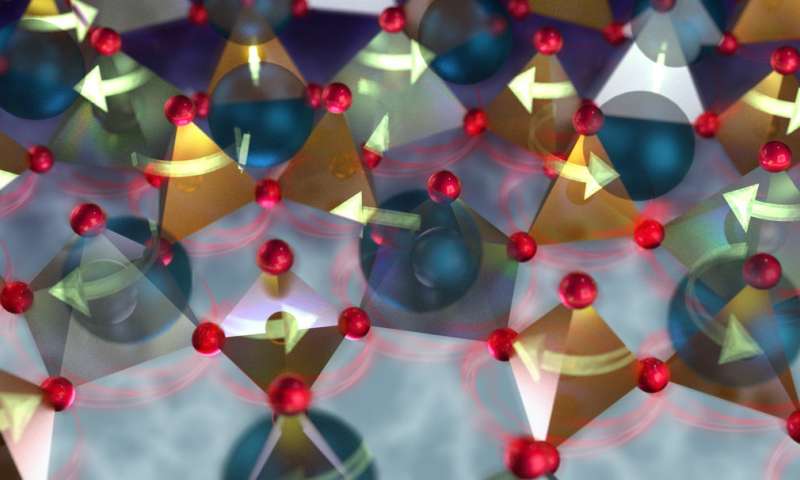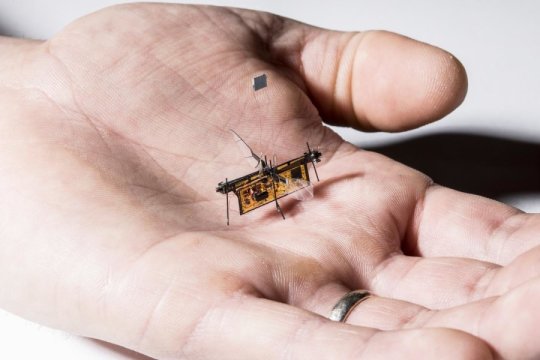
Supersonic waves may help electronics beat the heat (19/05/2018)
Researchers
at the Department of Energy's Oak Ridge National Laboratory made the first
observations of waves of atomic rearrangements, known as phasons, propagating
supersonically through a vibrating crystal lattice—a discovery that may
dramatically improve heat transport in insulators and enable new strategies for
heat management in future electronics devices.

Magnonic interferometer paves way toward energy-efficient information processing devices (19/05/2018)
Researchers
have designed an interferometer that works with magnetic quasiparticles called
magnons, rather than photons as in conventional interferometers. Although
magnon signals have discrete phases that normally cannot be changed
continuously, the magnonic interferometer can generate a continuous change of
the magnon signal. In the future, this ability could be used to design magnonic
integrated circuits and other magnonic devices that overcome some of the
limitations facing their electronic counterparts.

Researchers control the properties of graphene transistors using pressure (18/05/2018)
Researchers
have developed a technique to manipulate the electrical conductivity of
graphene with compression, bringing the material one step closer to being a
viable semiconductor for use in today's electronic devices.

Carbon-recycling system: Two-electron chemical reactions using light energy, gold (18/05/2018)
Scientists
are one step closer to building a carbon-recycling system that can harvest
solar energy to efficiently convert CO2 and water into liquid fuels. By
optimizing many parts of the system, the researchers say, they can now drive
two-electron chemical reactions, a substantial advance over one-electron
reactions, which are energy inefficient.

New robot concept uses responsive materials to swim through water (18/05/2018)
Engineers
at Caltech and ETH Zurich have developed robots capable of self-propulsion
without using any motors, servos, or power supply. Instead, these
first-of-their-kind devices paddle through water as the material they are
constructed from deforms with temperature changes.

The first wireless flying robotic insect takes off (18/05/2018)
Insect-sized
flying robots could help with time-consuming tasks like surveying crop growth
on large farms or sniffing out gas leaks. These robots soar by fluttering tiny
wings because they are too small to use propellers, like those seen on their
larger drone cousins. Small size is advantageous: These robots are cheap to
make and can easily slip into tight places that are inaccessible to big drones.

A quantum entanglement between two physically separated ultra-cold atomic clouds (18/05/2018)
Scientists
have achieved, in an experiment, quantum entanglement between two ultra-cold
atomic ensembles, called Bose-Einstein condensates, spatially separated from
each other.

Chemists create faster and more efficient way to process information (12/05/2018)
University
of Waterloo chemists have found a much faster and more efficient way to store
and process information by expanding the limitations of how the flow of
electricity can be used and managed.

Light could make semiconductor computers a million times faster or even go quantum (12/05/2018)
A
technique to manipulate electrons with light could bring quantum computing up
to room temperature.

A boost for graphene-based light detectors: Photoexcited graphene puzzle solved (12/05/2018)
Light
detection and control lies at the heart of many modern device applications,
such as the camera you have in your phone. Using graphene as a light-sensitive
material for light detectors can offer significant improvements with respect to
materials being used now. For example, graphene can detect light of almost any
color, and it gives an extremely fast electronic response within one millionth
of a millionth of a second. Thus, in order to properly design graphene-based
light detectors it is crucial to understand the processes that take place
inside the graphene after it absorbs light.









